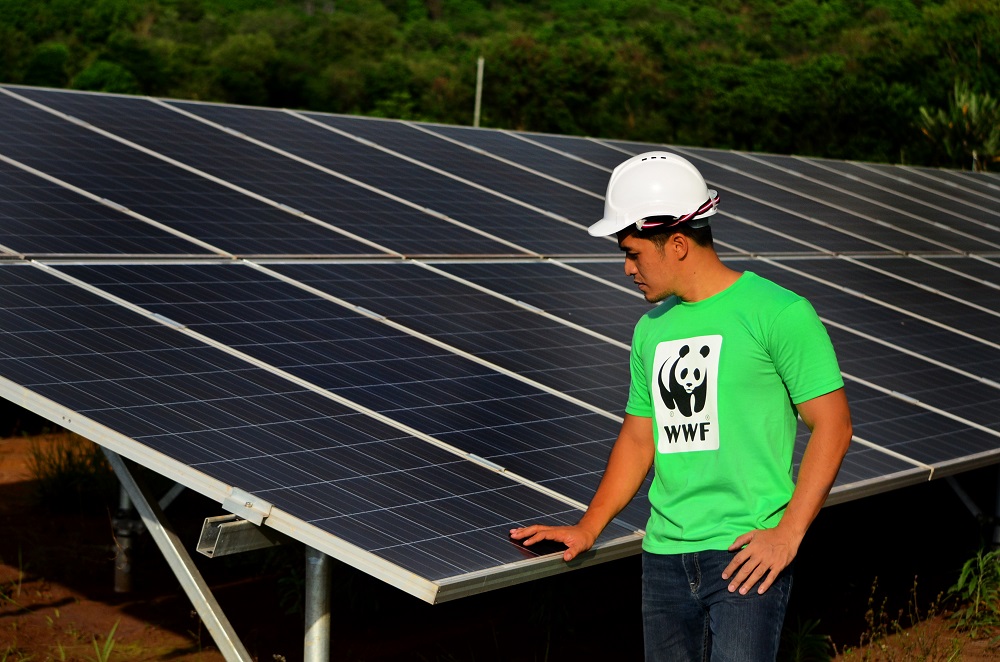Renewables Best Way to Power Philippine Development
February 2017
Renewable Energy (RE) investments have already saved the Philippines PHP4.04 billion, according to a Philippine Electricity Market Corporation (PEMC) report. Climate change solutions-provider World Wide Fund for Nature (WWF-Philippines) said that offsetting the cost of expensive fossil-fuels saved each Pinoy consumer 5.67 centavos, simultaneously generating more local jobs and reducing the country’s share of carbon emissions by an impressive 2.8 million tons.
“With the government’s Philippine Development Plan (PDP) for 2017 until 2022 now being finalized, we challenge the government to increase the share of RE to 50% by 2030,” explains WWF-Philippines climate and energy program head Atty. Gia Ibay. “Green and sustainable development fits perfectly with the administration’s mantra of Malasakit, Pagbabago at Kaunlaran because RE provides affordable, sustainable and accessible electricity – especially for remote communities.”
Clean and renewable energy sources like geothermal, hydro, wind, biomass and solar energy are among the country’s few competitive advantages – especially since it has no significant deposits of fossil-fuels. Its continued dependence on imported fuel has made Philippine electricity rates among the highest in Asia.
Relying more on RE has brought down the cost of electricity with fuel diversity, shielding Filipinos from price fluctuations as no fuel cost is incurred. This shows the care or Malasakit of the government, particularly coupled with increased energy access with distributed RE reaching off-grid communities.
Renewables currently account for just 30% of the country’s energy mix. The government-led National Renewable Energy Plan (NREP) aims to triple RE capacity to 15,304 MW by 2030 - but WWF thinks it can do much better. “We urge the government to ramp-up its RE efforts by fast-tracking RE mechanism implementation, setting clear targets on RE and promoting a more level playing field for all energy-generating technologies,” adds Ibay.
“The PDP should reflect the change or Pagbabago that we now see in the global arena – the shift away from the traditional mindset that the solution to our power needs is through the same old type of thermal-fired plants like coal. Our national development plan should realize the move towards distributed energy systems as it fits with the country’s archipelagic nature, while increasing grid reliability, decreasing costs and improving resilience to natural calamities.”
For years, WWF-Philippines has advocated for a shift to RE while optimizing energy usage. WWF’s study on Building Momentum for Low Carbon Development presents a viable roadmap for 100% RE, which is possible since the country hosts a vast potential of RE resources. WWF points out that the country can further develop 1200 MW of geothermal, 2308 MW of sustainable hydro, 235 MW of biomass and 7404 MW of wind generation capacity even before 2030. Further, WWF-Philippines has supported local power development planning to supplement distributed energy as it empowers the locals to craft their own energy path.
“We’ve already seen how RE can save us money by shielding us from the price volatility of fossil-fuels like gas, oil and coal – 90% of which are imported at wildly-fluctuating prices,” adds Ibay. “Shifting to renewables is our least expensive chance to achieve energy independence while fighting climate change. Moreover, it is perfectly in-line with the Duterte administration’s plans to achieve progress and energy security.”

WWF Energy Officer Raphael Dorilag inspects an array of solar panels at the Kirahon Solar Park in Villanueva, Misamis Oriental. WWF is a strong advocate of solar power and other forms of clean and renewable sources of energy.

For more information, please contact:
Head, Climate and Energy Program Ms. Angela Ibay (gibay@wwf.org.ph)
Energy Communications Officer, Mr. Aaron Aspi (aaspi@wwf.org.ph)
